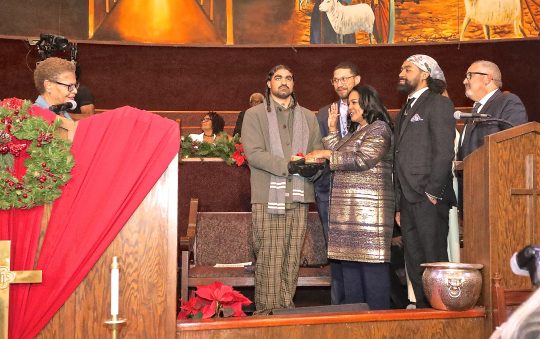
Despite all the stresses, division, and crises of the past year, we Americans have the timely opportunity to achieve the togetherness and mutual benefits in the new year that can mark a significant turning point. This opportunity lies within the recently passed $1.2 trillion brick-and-mortar infrastructure bill, which can help build bridges of inclusivity between mainstream construction industry businesses and small and diverse business enterprises, generate multiplicative community benefits, and serve as a replicable national model across many industries.
The upcoming massive expenditure of federal funds for much needed infrastructure improvements must include as much of the U.S. construction community as possible. We have so many able contractors, and we need to use all their talents so your commutes are less bumpy and less congested, so you have more viable options to use mass transit, and so the structures you enter are safer from earthquakes, etc. This means that our infrastructure policy must include a robust diversity, equity, and inclusion (DEI) component that helps break down barriers and provides equal contracting access. There needs to be fairness so that greater numbers of qualified — but heretofore excluded — hard hat wearing Johns and Janes from small and diverse firms can be seen on construction sites with clipboards, engineering drawings, and tools in hand.
Increasing the participation of small and diverse businesses generates multiple and local public benefits. These benefits include lower contracting costs, more creative and innovative work, business development and growth, job creation, stronger local economies, and more social and economic equity.
I have seen these positives firsthand, as my team and I have spent many years working as DEI consultants to public agencies. We have had the great fortune of being contracted by forward-thinking municipalities who saw the value of increasing DEI in public construction.
These intrepid municipalities created DEI programs, for example, which assist small and diverse construction contractors in bidding and obtaining work. Known generally as Contractor Development and Bonding Programs (CDABPs), these programs provide vital bonding assistance, contract financing, technical support, and other services to underrepresented businesses, which include disadvantaged, minority, small, local, women, and disabled veteran owned business enterprise categories.
To provide a quick real-world example, here are some specifics regarding ongoing CDABPs in Los Angeles, San Francisco, and Alameda County in California: For these three municipalities, the collective multi-year cumulative totals to date are over 1,000 bid bond transactions on over $1 billion in construction and other work and over $300 million in awarded contracts to underrepresented firms who would not have been qualified to bid otherwise. In addition, the CDABPs have produced a cumulative cost savings of over $20 million in taxpayer dollars due to the CDABP assisted firms competitively bidding and winning contracts against other businesses that submitted more costly second place bids. Furthermore, for all the above activity only two contractors failed to complete projects since the first program’s inception nearly 25 years ago. As a result, the default rate of the programs has been less than one tenth of one percent, far below the overall standard construction industry default rate of over 20 percent.
This example provides compelling evidence that despite long-held misperceptions, small and diverse firms have the aptitude and attitude to successfully win and perform work when systemic barriers are removed.
These types of DEI programs are a win-win for government agencies and the public. By enabling more underrepresented companies to bid on projects — which are commonly awarded on a low-bid basis — government agencies create an expanded and more competitive bidding pool, which can generate more creativity and innovation and lead to lower contract costs, thereby saving taxpayers money. These types of programs also create more higher paying jobs in local communities, as small and diverse firms tend to hire workers from their own communities. This fosters more robust local economies as more contracting dollars are spent locally.
Given these powerful multiple benefits, DEI should be infused within infrastructure legislation, and there must be linkage between policy, practices, and programs.
The policy should explicitly express DEI expectations and requirements. It should acknowledge and vow to reduce systemic exclusionary practices and other obstacles. The legislative intent and tone should be clear, strong, and supportive of effective DEI programs.
Contracting practices must also reflect the policy intent. Government officials are positioned to ensure that the legislative intent of the policy carry over undiminished to the officials and agencies tasked with implementing the policy. For example, the agencies must take a hard look at their contracting and proposal requirements to ensure that they are unbiased and include fair bid and scoring systems (which can include the quality of a bidder’s DEI plan along with the typical experience, approach, and cost scoring categories).
The programs must dismantle systemic obstacles to DEI, including the long-standing bias of defining qualified as big or mainstream. There must be vigilant oversight of program operations to ensure that we move the needle on outcomes.
With linked policies, practices, and programs, we can achieve multiple objectives via the $1.2 trillion infrastructure bill, a once-in-a-generation opportunity. We can build the vital brick-and-mortar bridges, roads, and other vital projects. Simultaneously, we can build DEI bridges across America by enabling the inclusion of small and diverse firms to work in partnership with mainstream construction businesses. In doing so, we can create a national DEI model that can be applied in other public and private industries.
Diversity, equity, and inclusion are essential to our collective lives and are a win-win for everyone. All the qualified Johns and Janes contractors across our diverse America deserve a fair chance to work on public projects. Let’s create an infrastructure policy that builds back better two types of bridges for a more inclusive and stronger nation. The costs of inequity in public contracting are in the hundreds of millions of dollars per year, and we the taxpayers are paying for the inequities. Let us collectively work to change that for the benefit of all of us.
Ingrid Merriwether is the founder and CEO of Merriwether & Williams Insurance Services, which has many years of experience working on public construction contracting and diversity, equity, and inclusion (DEI) issues. E-mail: ingrid@imwis.com






